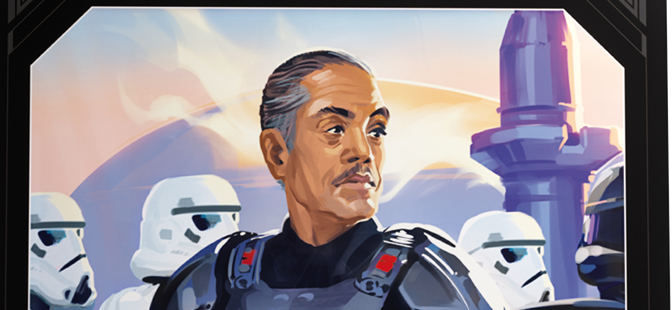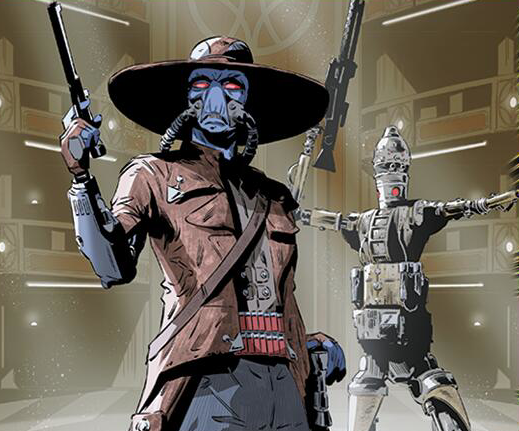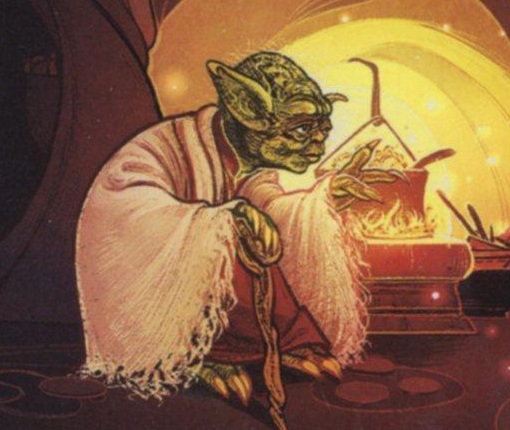Table of Contents
So you're interested in attending a draft at your local game store. Whether you're new or a veteran, that's a great choice! For new players, draft is a great way to be on an even playing field with everyone else sitting down at the event. Nobody can come with the latest refined meta deck and steamroll your kitchen-table tested list. Everyone is on the exact same playing field and at the mercy of pack luck and deck-building experience.
For more experienced players, draft is great for exactly that.... test your deck-building experience in an environment that feels fresh every time. Whether you're looking for an escape from a stale meta or just looking to test your prowess in a different sort of environment, draft is a great way to do it.
The Elephant in the Room
Draft is a format that requires a decent amount of player skill, and I don't think it would be fair to write this guide without mentioning that. HOWEVER, before newer players leave, that doesn't mean that draft isn't for you!
Draft is actually a great way to learn how to play the game. You will build such strong fundamentals in how you see different lines of play and learn which part of your deck has which job in your games. I think the best players of any card game are players that thrive within a limited environment like draft. (Insert that picture of Obama giving himself the medal here).
My reasoning for this is the following: If you want to get very good at one deck, the best way to do that is to get reps in with that deck. Learn all your match-ups, and play hundreds of games with it. Also play against it, get a friend who you think is a strong player and have them pilot the deck you want to get good at, that's a great way to get into your opponents heads so that you can have more in depth counter-play.
If your goal is to win a specific constructed tournament, the best way to do that is to find a deck you like and grind for days.
HOWEVER, while that will definitely make you a better player, I think the player who has spent that time drafting and deckbuilding will broadly have stronger fundamentals, and will be able to pick up other constructed decks quicker.
While I have no way to prove this, I have noticed it across both Star Wars Unlimited and Magic: The Gathering. The players who come out to drafts consistently are some of the strongest players.
Now of course, correlation is not causation, players who come out to more drafts are likely more interested in the game and spend more time thinking about it blah blah blah I know, but I digress. The point of this section is that while draft is hard, it's genuinely a GREAT way for a new player to get very strong fundamentals, since it forces you to think about all elements of the game when making decisions, not just current meta-relevant ones.
OK, but how do I even draft?
First of all, I'm glad my disclaimer didn't scare you away. Welcome to the guide! So how do we actually draft? Heads up, this section will be VERY fundamental, so feel free to skip to the next section if you already know how to draft.
So draft is a process that is designed with 8 players in mind, but you don't NEED 8. 6 works fine, as does 10. Honestly, any number is okay, but the closer to 8 the better.
Next, get each player 3 packs of whatever set you want to draft. ALL packs should be the same set (for example, Jump to Lightspeed). You CAN technically draft with packs of a different set, but things can get a little weird. Definitely a fun activity for when you're more experienced!
Once each of you have 3 packs, sit around a table in a way that you have access to the person to your left AND the person to your right. Now that everyone has taken their seats, the draft can begin.
First, open all 3 packs, but DO NOT look at any of the cards inside them, just take out the leader from each pack and set the rest of the cards back inside the packs from which they came. DO NOT mix the packs.
Now you should be holding 3 leader cards. Take 1 of them and pass the other 2 to your RIGHT. Then, look at the 2 leaders the person to your left passed you. Take 1 and pass the other to the right. Then take the last leader given to you.
Great! You're done the first part of the draft. Each player should now have 3 leaders in front of them. We will talk about strategy for choosing leaders later in the article.
Now, it's time to draft your deck. Set your leaders to the side and pick up one of the packs in front of you. Unlike the leader draft, drafting the rest of your deck is PRIVATE, so you shouldn't let the folks next to you see what's in your pack or what card you end up picking.
Look through the cards in your hand and pick one that you want in your deck. Then, give the remaining cards (face down) to the person to your LEFT. Take the pack given to your by the person on your right and take a card out of that pack. Repeat this process until the first pack is completely empty. Once everyone has gotten their last card, you can look at your second pack. The process for this pack is exactly the same, but this time it goes to the RIGHT instead of the left. When your second pack is done, repeat one last time with your third pack, which goes back to the LEFT.

Retrieved from: https://magic.wizards.com/en/news/feature/what-booster-draft-and-how-it-done-2017-11-07
On April 4th, 2025.
And you're done! That's the draft process. You should have 3 leaders and 45 cards in a pile in front of you. You can NOT trade any of the cards that you opened during the draft with other players at the table until AFTER the event has concluded, as putting cards in your deck that you didn't draft is considered cheating.
Now it's time to build a 30 card deck using one of your leaders. If you didn't draft a base of the aspect you need, don't fret! Common, 30 life bases are the one exception to the trading rule. If you play magic, think of them like basic lands. Typically someone at your table will have drafted the basic base you're looking for and will be chill enough to let you borrow it. If they're not that's OK, just write "vigilance base, 30" on the back of a napkin. Good enough. If you want to play one of the rare bases you DO need to draft that, and can't trade for that.
Importantly, you CAN run more than 30 cards if you want. You cannot run fewer than 30 cards. (Unless you drafted a Thermal Oscillator, You should aim to run the minimum amount). You can also run cards out of aspect if you want, you will just need to pay an extra 2 for the card per missing aspect, as per usual.
One small thing: in typical Star Wars Unlimited, you can only have up to 3 copies of any one card in your deck. In draft that restriction is lifted. If you manage to get 4 or more of a single card and you want to run all of them in your deck, you are free to do so! This won't come up too often, but it's cool when it does.
And that's it! Once you've built your deck, you'll play games against other folks in whatever tournament structure you or your local game store decided to run. Keep in mind that you are typically welcome to change the cards in your deck between rounds, so long as everything was in your draft pool.
Now let's get in to specific beginner tips for each phase of the draft and deckbuilding process.
Leader Drafting
The leader draft is the shortest part of the draft but one of the most impactful. I'm going to try to avoid recommending specific leaders and mechanics, since I want this guide to act as general one that will be relevant over multiple sets. I see drafting a leader as having two "tiers" of important.
Tier 1: Drafting leaders that offer a good spread of aspects, ESPECIALLY heroism and villainy.
You don't want to be the person who drafted 3 heroism leaders and everyone around you is in heroism around you in the table. If everybody is sucking up all of the heroism cards around you, you want to be able to take villainy cards, and vice versa. Having at least 1 leader of heroism and 1 of villainy is THE SINGLE MOST IMPORTANT part of drafting leaders in my opinion. Make sure you do this over all else.
Tier 2: Literally everything else. (primarily leader mechanics and deploy turn)
Generally speaking, leaders who deploy earlier are stronger in draft. This is just a heuristic, and isn't always true, but getting a deploy on 5 while your opponent doesn't get to deploy until 7 can pretty easily let you run away with a game. Also, be on the lookout for synergy if you know the set. Of course, you won't know what cards you're drafting until after you've drafted your leaders, but you can make a judgment of the likelihood of getting certain synergy pieces based on the frequency of those pieces in the set. For example Luke Skywalker, Hero of Yavin is a strong leader in Jump to Lightspeed draft in part due to the abundance of fighters.
Card Drafting
So you've taken your leaders and now you're getting into the draft portion. This is the most involved and complicated part of the process, and you'll still be learning things years from now about how to make very subtle changes to your strategy. Every time I sit down for a draft I learn something new. So don't panic if this seems hard! Even the most experienced person at your table is not doing this perfectly.
If you've ever drafted Magic: The Gathering, you may have heard of the BREAD method. If not, don't worry! I'll very briefly explain it here.
BREAD is an acronym used to explain draft to new players. It is the order in which you should be drafting cards. Star Wars Unlimited is not Magic: The Gathering, so things are a bit different, let's build a new acronym. I would like to unveil my own proprietary BARESS system. Wow! So exciting.
B - Bombs: These are your highest priority cards. A bomb is a card that will get you a massive advantage in the game. They are often either very efficient units like Luke Skywalker, Jedi Knight, or very efficient removal like Overwhelming Barrage.
A - Ambush: Ambush is by far the strongest keyword in draft. Oftentimes it can compete with removal and some folks would take it above removal, which I think is sometimes correct. I have put it above removal for no reason in particular, and I think they can be drafted at equal importance, deferring to the efficiency of the removal or ambush card to break ties. The reason why Ambush can sometimes be better than removal is because there are instances where you'd play an ambush unit and immediately take out one of your opponents units and leaves behind yours. This basically acted as a unit AND removal.... all one one action!
R - Removal: These are cards that deal with your opponents threats. Cards like Vanquish and Open Fire are removal. Even though cards like Spark of Rebellion are TECHNICALLY dealing with your opponents threats and can still be solid, they should not be taken as highly as board control removal like the above mentioned cards.
E - Efficient: It sounds kind of silly to say but you'd be surprised by the amount of people that overlook this. Just.... having units with good stats and good costs with maybe a little "When Played" ability will oftentimes just get you there. There isn't a worse feeling than when your opponent is playing to the board and you are stuck with a hand of cards that buff your units. Sure that buff may be nice, but if you don't have any units it doesn't matter. Draft efficient units very very highly.
S - Synergies: At this point in the draft, you know what leaders you have. It's going to be impossible to know for sure which one you are playing in the first few picks, but if you see some card that works very well with one of your leaders, then you can definitely consider that as an option.
S - Symmetry: At casual drafts, you are allowed to look at the pile of cards you've already drafted at any point. You want to make sure that you have units across many costs (with an emphasis on 2 and 3 cost cards, more on that later) and both the space and the ground arena. It's totally fine to have a focus on one arena if it goes okay with your game strategy (and depending on the set you're drafting) but in draft completely ignoring one arena will often not go well for you.
Now, this is a beginners guide. These sorts of heuristics are great for beginners, but as you practice more you'll make your own modifications to it. That's totally okay! I would be concerned if someone had been drafting for years and still exactly followed BREAD or any other heuristic. All this to say, if you're in your draft and you see a card that you think will work REALLY well in your deck and you're debating whether to take it over removal.... give it a try! Worst case scenario is that it doesn't work out and you can review WHY it didn't work out. The best way to get better is to mess around a little bit!
Drafting a Curve
One thing that never goes out of style is playing units. Ultimately the reason I constructed the BARESS acronym the way that I did is that each of those letters causes you to draft something that has an effect on the board. Having units to play every turn is about the most important thing you can do in any draft game of Star Wars Unlimited. The distribution of resource costs is known as your Curve.
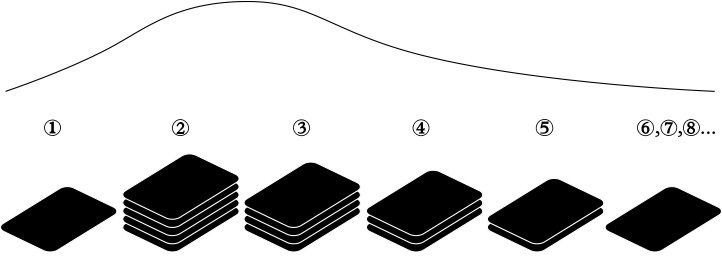
Retrieved from: https://magic.wizards.com/en/news/feature/how-build-mana-curve-2017-05-18
on April 4th, 2025.
There is no hard and fast rule to exactly how many of each cost you should have in your draft deck, but there are trends. 2 and 3 cost cards (mostly units) should take up half of your deck. You want to make sure that you can virtually always play something ON CURVE (using all of your resources) at least for the first 2 turns of the game. A few efficient 4 and 5 cost cards are necessary to follow up and keep board control in the mid-game. A couple of 6-7 cost cards are nice to have to close out the end game. Anything over 7 you need to have a very good reason to be running, but in particularly strong cases it can be right to do. These ultra high-cost cards should be reasonably playable (no Endless Legions, I'm sorry) and be able to support your winning of the game immediately. Supreme Leader Snoke, Shadow Ruler is a great example of a card like this.
A recent draft I did had a curve like this:
- 1 cost: 2
- 2 cost: 8
- 3 cost: 9
- 4 cost: 5
- 5 cost: 1
- 6 cost: 3
- 7 cost: 2
Not a perfect curve by any means, but it illustrates how weighting lower cost cards is generally a good idea, so long as you have a couple of larger options to help close out games.
If there is one thing that I want you to take away from this guide it is to draft your 2 and 3 cost units before you think about drafting any exciting non-removal event cards. Eat your vegetables, as MTG draft commentator Marshall Sutcliffe would say.
There are a lot more tips that are very important for drafting a good deck, but they're a bit more intermediate. I will write another guide on that another time, but do a couple of drafts with this info and get your footing before worrying too much about things like signals, pivoting, and hate-drafting
Deckbuilding
You're done the hardest part of the whole process - the draft. Congratulations! Decks in Star Wars Unlimited Draft often build themselves with a few exceptions. At this point you should know what aspects you are in (if you don't, something went wrong in the drafting phase). You will now build a deck of 30 cards. Clear some space on the table in front of you and let's get to work!
There is a good chance you were forced to draft some cards that are not in your aspects on the tail end of packs. Don't worry, this is completely normal. The first thing I would suggest doing is set those aside so you're only working with cards in your aspect.
Next, lay those cards out by cost, the divide each cost into three piles, one for ground units, one for space units, and one for non-units. You should be looking at a grid. This will help you visualize your resource curve, and which areas may be lacking.
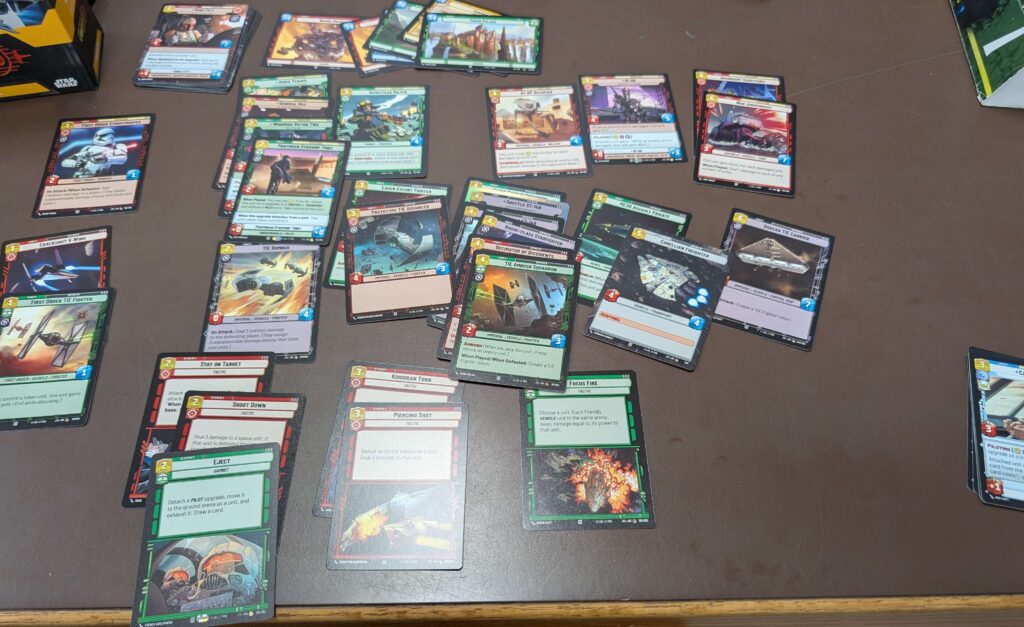
Now comes the hard part of deck-building. Cutting or adding cards. If you have more than 30 cards, you virtually ALWAYS should cut down to 30 cards. This is a mistake I see beginners or even intermediate players make all the time. The logic seems sound: if I have 32 good cards, why would I not play all 32 good cards? The answer to that question is deceptively simple. In the case where you have 32 "good" cards, two of them are the worst cards in your deck. Why would you play the 2 worst cards in your deck? The answer is that you shouldn't. Try your best to cut down to 30.
How do you know which cards to cut? That's part of the reason why we laid out the cards in the way we did. Even if some random 3 cost card is the "worst" card in your deck, you should think twice about cutting it if you are low on other 3 cost cards. This is something that's quite easy to see when the cards are laid out by cost as described above.
In general, having too many cards is actually a good problem to have. It means you probably were drafting the right cards during the draft process, and having cards to "cut" from your final list is a luxury not all players will have.
Now adding cards into your deck is a bit trickier. If you end up with less than 30 cards on aspect, you will need to look through the other cards you got that are out of aspect for filler. Don't worry, you didn't necessarily do anything wrong. Sometimes this just happens, although it's usually not ideal.
Remember, you can play off-aspect cards in your deck, just like in constructed. You will just have to pay an extra 2 resources for each aspect that you don't have in your leader or base. There is a good chance that in your small pile of off-aspect cards, there will be some strong ones. Take stock of what your deck needs. Are you low on removal and have an off-aspect piece of removal? That sounds very reasonable to throw that in. Are you missing some top end bomb but have an off-aspect option to close out games? Throw it in.
Remember, if you draw your off-aspect cards at the wrong time, you can just use them as resources.
Conclusions and Final Thoughts
And voila! Grab your leader and base and play your first games as per your local game store's tournament structure! In my experience the community is quite friendly, so if you have any questions feel free to ask someone nearby or a store employee. They'll be happy to help or point you to someone who can. We love seeing new players joining the game, as it's great for the game we love's health and longevity.
Not only is drafting a great way to learn new cards, build game knowledge, get unique and interesting games in, and get involved with a local community, but it's also a great way to build your collection! Some people buy and crack boxes, and that's awesome. I've done that in the past and it's definitely fun. But these days I don't buy as many boxes, as doing enough drafts is a great way for me to get all sorts of new cards that I need for decks, AND I get to play with the cards. Opening a box is a good 40~ minutes of fun. Drafting can be a blast for a whole afternoon!
If you did well enough in the draft, most stores will also have prizing, giving you a couple of bonus packs to take home! Regardless of how you finish, you'll also be given at least one promo pack, with unique art on cards from that set. You won't be able to find those treatments in regular packs!
If you didn't win any games don't worry! Draft is a complicated format. Even when you're experienced sometimes you just have nights where either the draft portion or the games don't go your way. What I would recommend doing is keep your deck together and see if you can play a few extra games with it for fun either at home or at the store. Now that the stress of having prizing on the line has subsided, really think about the plays you're making and how you're reacting to your opponent's plays. At the end of the day practice makes perfect, and if you spend a bit of extra time each event really thinking about how you could make things go better, I can virtually guarantee that you'll improve very quickly, and be taking tournaments home in no time at all!
Draft is hard, and you should pat yourself on the back for diving in head first! If you'd like to learn more in depth about draft, check out my Youtube channel, where I talk regularly about it and do more rigorous draft analyses. Also, keep an eye out for a more intermediate/advanced draft article that I will likely write in the next few weeks. Find the companion video for this article here.
Thank you for your time, and as always, May the Force be with You!


